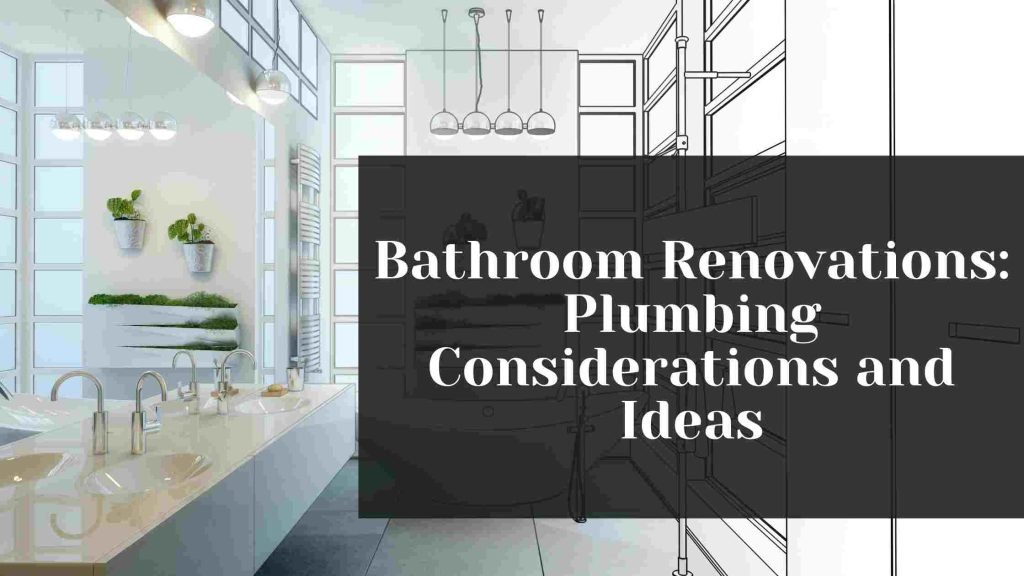Hey there, home improvement enthusiasts! So, you’re gearing up for a bathroom remodel, huh? Exciting stuff! But before you dive headfirst into picking out tiles and fixtures, let’s chat about something super important: plumbing considerations. Yep, you heard me right! Plumbing might not be the most glamorous aspect of remodeling, but trust me, it’s absolutely crucial. In this guide, A.C.E. Plumbing And Home Services LLC will take you to uncover the ins and outs of plumbing considerations in bathroom remodeling, so you can avoid potential headaches and ensure your new bathroom is as functional as it is fabulous. Ready to dive in? Let’s get started!

Think about it – your bathroom’s plumbing system is like its lifeline, responsible for everything from that refreshing morning shower to keeping things flowing smoothly down the drain. Ensuring proper plumbing considerations during your remodel guarantees not just functionality but also longevity and efficiency for years to come. So, let’s roll up our sleeves and delve into the world of bathroom remodeling services, shall we?
Understanding the Importance of Plumbing in Bathroom Remodeling
Choosing the right professional bathroom remodeling service is the backbone of any remodel, dictating the functionality and efficiency of the space. It’s essential to grasp the vital role these experts play in ensuring everything from water flow to drainage operates smoothly. From showering to using the sink or toilet, every aspect relies on a well-designed plumbing system. Understanding the importance of selecting the right remodeling service guides decision-making throughout the process, ensuring that both aesthetic desires and practical needs are met seamlessly.
Assessing Existing Plumbing Infrastructure
Before diving into stunning bathroom transformations, it’s crucial to assess the condition and layout of the existing plumbing infrastructure. Understanding where pipes run, their condition, and any potential issues lays the foundation for the remodeling project. This assessment helps identify areas for improvement or updates, ensuring that the new design integrates seamlessly with the existing plumbing system. By conducting a thorough evaluation upfront, surprises and complications during the renovation process can be minimized.
Planning for Layout and Fixture Placement
Careful planning of the layout and fixture placement is essential for optimizing space and functionality in a bathroom remodel. Consider factors such as traffic flow, accessibility, and ergonomics when arranging fixtures like sinks, toilets, showers, and bathtubs. Ensure adequate space around each fixture for comfortable use and maintenance access. Additionally, plan for efficient water supply and drainage connections to minimize plumbing disruptions and maximize convenience. By thoughtfully designing the layout and placement of fixtures, you can create a bathroom that is both aesthetically pleasing and highly functional.

Upgrading Plumbing Fixtures for Efficiency and Style
Upgrading plumbing fixtures presents an opportunity to enhance both efficiency and style in a bathroom remodel. Choose fixtures that not only complement the overall design aesthetic but also offer water-saving features for improved sustainability. Options such as low-flow faucets, dual-flush toilets, and water-efficient showerheads can help reduce water consumption and lower utility bills. Additionally, select fixtures in finishes that align with the desired design theme, whether it’s modern, traditional, or somewhere in between. By upgrading plumbing fixtures, you can elevate the look and performance of your bathroom while also promoting water conservation.
Addressing Drainage and Ventilation Needs
Proper drainage and ventilation are essential considerations in bathroom remodeling to prevent moisture-related issues and maintain indoor air quality. Ensure that drains are properly sized and positioned to effectively remove wastewater and minimize the risk of clogs or backups. Incorporate ventilation solutions such as exhaust fans or windows to reduce humidity levels and prevent mold and mildew growth. Properly addressing drainage and ventilation needs not only promotes a healthier environment but also prolongs the lifespan of fixtures and finishes in the bathroom.
Incorporating Water Efficiency Measures
Incorporating water efficiency measures is key to sustainable bathroom remodeling. Choose fixtures and appliances with high-efficiency ratings, such as toilets, faucets, and showerheads, to reduce water consumption without sacrificing performance. Consider installing a greywater recycling system to reuse water from sinks and showers for non-potable purposes like toilet flushing or landscape irrigation. Additionally, incorporate sensor-operated or touchless fixtures to minimize water waste from unnecessary usage. By prioritizing water efficiency measures, you can reduce your environmental footprint and lower utility costs while still enjoying a functional and stylish bathroom.
Ensuring Proper Pipe Sizing and Material Selection
Ensuring proper pipe sizing and material selection is essential for a reliable and long-lasting plumbing system in a bathroom remodel. Choose pipes with the appropriate diameter and material based on water flow requirements, local building codes, and environmental factors. Common pipe materials include copper, PVC, and PEX, each offering different benefits in terms of durability, cost, and ease of installation. Additionally, consider factors such as corrosion resistance and temperature tolerance when selecting pipe materials to ensure compatibility with water quality and usage conditions. By prioritizing proper pipe sizing and material selection, you can avoid plumbing issues and ensure the integrity of your bathroom’s plumbing system for years to come.
Considering Accessibility and Aging-in-Place Features
Considering accessibility and aging-in-place features is important for creating a bathroom that accommodates users of all ages and abilities. Incorporate design elements such as curbless showers, grab bars, and adjustable-height fixtures to enhance accessibility and promote safety. Ensure that doorways and pathways are wide enough to accommodate mobility aids such as wheelchairs or walkers. Additionally, choose slip-resistant flooring materials and install adequate lighting to minimize trip and fall hazards. By integrating accessibility features into the design, you can future-proof your bathroom and create a space that remains functional and welcoming for years to come.
Hiring Professional Plumbing Contractors
Hiring professional plumbing contractors is essential for ensuring the success of a bathroom remodel. Experienced plumbers have the knowledge, skills, and tools to handle complex plumbing installations and repairs safely and efficiently. They can help navigate building codes and permit requirements, ensuring that the remodel complies with regulations and standards. Additionally, professional plumbers can provide valuable insights and recommendations based on their expertise, helping to optimize the design and performance of the plumbing system. By entrusting the plumbing work to qualified professionals, you can have peace of mind knowing that your bathroom remodel is in capable hands.

Budgeting for Plumbing Costs and Contingencies
Budgeting for plumbing costs and contingencies is crucial for avoiding financial surprises during a bathroom remodel. Allocate a portion of your overall budget specifically for plumbing-related expenses, including fixture upgrades, pipe replacements, and labor costs. It’s also wise to set aside funds for unexpected issues or changes that may arise during the project. Working with a reputable plumbing contractor can help provide an accurate estimate of costs upfront and identify potential areas where savings can be achieved. By budgeting appropriately and planning for contingencies, you can ensure that your bathroom remodel stays on track financially and meets your expectations.
Final Inspections and Quality Assurance Measures
Final inspections and quality assurance measures are essential steps in ensuring that the plumbing work meets regulatory standards and performs as intended. Schedule inspections with local building authorities to verify compliance with plumbing codes and regulations. Conduct thorough testing of all plumbing fixtures and connections to identify any leaks or malfunctions. Address any issues promptly to prevent further damage and ensure the safety and functionality of the plumbing system. Additionally, document all work performed and retain copies of permits and inspection reports for your records. By completing final inspections and quality assurance measures, you can have confidence that your bathroom remodel meets the highest standards of quality and craftsmanship.
Conclusion
In conclusion, plumbing considerations are integral to the success of any bathroom remodeling project, ensuring functionality, efficiency, and longevity for years to come. From assessing existing infrastructure to planning layout and fixture placement, each step plays a crucial role in creating a well-designed and reliable plumbing system. By incorporating water-efficient fixtures, addressing drainage and ventilation needs, and prioritizing accessibility features, homeowners can enhance both sustainability and safety in their bathrooms. Hiring professional plumbing contractors and budgeting for costs and contingencies are essential steps to ensure a smooth and successful remodel. Finally, conducting final inspections and quality assurance measures provides peace of mind that the plumbing work meets regulatory standards and performs optimally. With careful planning, attention to detail, and the expertise of professionals, homeowners can achieve their dream bathroom while minimizing potential issues and maximizing satisfaction.
FAQs
Why is plumbing so important in bathroom remodeling?
Plumbing is crucial as it ensures proper water flow, drainage, and functionality of fixtures like sinks, showers, and toilets, essential for daily use.
What should I consider when upgrading plumbing fixtures during a remodel?
Consider factors such as water efficiency, style compatibility, and durability to ensure the fixtures enhance both the aesthetic and functionality of the bathroom.
How can I address accessibility needs in a bathroom remodel?
Incorporate features like grab bars, curbless showers, and wider doorways to enhance accessibility and promote safety for users of all ages and abilities.
What are common challenges homeowners face with bathroom plumbing during remodeling?
Challenges may include outdated plumbing infrastructure, unforeseen issues like leaks or clogs, and navigating local building codes and permit requirements.
Why is it important to hire professional plumbing contractors for a bathroom remodel?
Professional plumbers have the expertise to handle complex installations, ensure compliance with regulations, and address any issues promptly, resulting in a successful and stress-free remodel.
